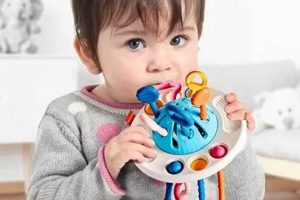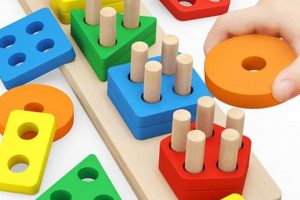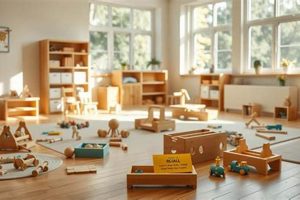Educational materials designed for children around a year and a half old, based on the Montessori educational approach, typically emphasize hands-on learning, practical life skills, and sensory exploration. These materials might include wooden puzzles, stacking toys, sorting activities, and objects for practicing fine motor skills. A simple example is a set of wooden blocks of varying sizes that a child can stack and arrange.
Such learning tools can foster independence, concentration, and a love of learning at a crucial developmental stage. They encourage children to explore their environment, develop problem-solving skills, and gain confidence through self-directed activities. The Montessori method, developed by Dr. Maria Montessori, emphasizes self-directed learning, hands-on activities, and collaborative play. This pedagogical philosophy recognizes the importance of providing developmentally appropriate activities for children at each stage of their growth.
This article will delve into various aspects of selecting, using, and adapting these educational materials. Topics covered will include specific examples of appropriate materials, how they support development, creating a supportive home learning environment, and addressing common parental concerns.
Tips for Utilizing Montessori Materials for 18-Month-Olds
The following suggestions offer guidance on maximizing the benefits of developmentally appropriate learning materials for toddlers.
Tip 1: Observe the Child’s Interests: Materials should align with a child’s current developmental stage and interests. If a child shows a strong interest in manipulating small objects, offer activities that refine fine motor skills.
Tip 2: Rotate Materials Regularly: To maintain engagement and prevent boredom, rotate available materials. This practice reintroduces familiar toys with a renewed sense of discovery.
Tip 3: Provide a Prepared Environment: A dedicated space with low shelves and accessible materials allows children to choose activities independently, fostering self-reliance.
Tip 4: Focus on Practical Life Skills: Activities like pouring, scooping, and transferring objects develop essential coordination and concentration skills.
Tip 5: Embrace Simple Materials: Natural materials like wood, cloth, and metal offer sensory richness and durability. Avoid overly stimulating electronic toys.
Tip 6: Allow for Uninterrupted Work Periods: Children need uninterrupted time to focus and explore chosen activities. Minimize distractions and allow them to complete tasks at their own pace.
Tip 7: Observe and Guide, Don’t Interfere: Allow children to explore and discover independently. Offer guidance only when needed, fostering problem-solving skills and self-confidence.
By following these tips, caregivers can create a supportive environment that nurtures a child’s natural curiosity and encourages a lifelong love of learning.
This understanding of the practical application of Montessori principles provides a solid foundation for making informed decisions regarding a child’s early education.
1. Practical Life Skills
Practical life skills form a cornerstone of the Montessori approach for 18-month-old children. These activities focus on developing essential skills for everyday living, fostering independence and self-sufficiency. They provide opportunities for children to engage with their environment in meaningful ways, building confidence and coordination.
- Dressing Frames:
Dressing frames, such as those with zippers, buttons, or buckles, allow children to practice essential dressing skills. These activities refine fine motor control, hand-eye coordination, and problem-solving abilities as children manipulate the different fasteners. Mastering these tasks builds self-reliance and prepares children for real-life dressing challenges.
- Pouring and Transferring:
Activities involving pouring dry goods (like beans or rice) or liquids between containers enhance hand-eye coordination and concentration. These exercises develop fine motor control, spatial awareness, and precision, supporting independence in everyday tasks like serving food or drinks.
- Food Preparation:
Simple food preparation tasks, like spreading, cutting soft fruits with a blunt knife, or washing vegetables, offer opportunities to participate in meal preparation. These activities promote practical skills, healthy eating habits, and an understanding of food origins, fostering a sense of responsibility and contribution within the family.
- Cleaning and Care of Self and Environment:
Activities like wiping spills, dusting, or putting away toys instill a sense of order and responsibility. These tasks develop practical skills, encourage environmental awareness, and promote a sense of ownership and pride in caring for personal belongings and shared spaces.
These practical life activities, integrated through carefully selected educational materials, lay a strong foundation for independence, self-care, and a sense of responsibility in young children. This emphasis on practical skills not only equips children for everyday tasks but also contributes significantly to their cognitive and emotional development within the Montessori framework.
2. Sensory Exploration
Sensory exploration plays a vital role in the development of 18-month-old children, and Montessori-aligned toys offer rich opportunities for such exploration. These toys engage multiple sensestouch, sight, sound, smell, and sometimes even tasteallowing children to discover the world around them through direct experience. This hands-on engagement fosters cognitive development, refines motor skills, and builds a foundation for future learning. Sensory exploration contributes significantly to a child’s understanding of various textures, shapes, colors, and sounds, supporting language development and problem-solving skills.
Examples of Montessori-inspired sensory toys for this age group include textured balls, wooden blocks with different surfaces, sound cylinders, and simple puzzles. These materials provide opportunities for children to manipulate objects, discriminate between various sensory inputs, and make connections between their actions and the resulting sensations. A child might explore a textured ball, noticing the difference between a rough patch and a smooth one. Stacking wooden blocks can help develop spatial reasoning and an understanding of cause and effect. Sound cylinders encourage auditory discrimination as children learn to differentiate between varying pitches and volumes. Such experiences are essential for building neural pathways and developing cognitive skills.
Understanding the importance of sensory exploration in child development informs the selection and utilization of appropriate Montessori materials. By providing a rich and stimulating sensory environment, caregivers can support a childs natural curiosity and encourage active learning. Incorporating sensory activities into daily routines offers valuable opportunities for exploration and discovery, leading to a deeper understanding of the world and laying the groundwork for more complex learning concepts later on. This emphasis on sensory exploration is not merely about entertainment; it is a crucial component of a child’s cognitive, social, and emotional growth within the Montessori framework.
3. Fine Motor Development
Fine motor development is a critical aspect of a child’s growth around 18 months of age. Montessori materials specifically designed for this age group play a significant role in nurturing these skills. These materials offer opportunities for children to refine hand-eye coordination, strengthen small muscles, and develop precision in their movements. This focus on fine motor development not only enhances physical dexterity but also lays the foundation for essential skills like writing, drawing, and self-care tasks.
- Grasping and Manipulation:
Toys that encourage grasping and manipulating objects of various sizes and shapes help refine hand and finger control. Examples include small wooden blocks, stacking rings, and puzzle pieces. These activities strengthen the muscles in the hands and fingers, improving dexterity and preparing children for tasks like holding utensils, buttoning clothes, and turning pages in a book.
- Pincer Grasp:
The pincer grasp, the ability to hold small objects between the thumb and index finger, is a crucial milestone. Montessori materials such as small beads for threading or transferring with tweezers provide opportunities to practice this skill. Developing a strong pincer grasp is essential for future writing, drawing, and manipulating small objects in everyday life.
- Hand-Eye Coordination:
Activities like placing pegs in a pegboard, stacking blocks, or pouring materials from one container to another enhance hand-eye coordination. These exercises require children to visually track their movements and coordinate them with their hands, improving precision and control. This skill is fundamental for various activities, including catching a ball, using scissors, and eventually writing.
- Bilateral Coordination:
Using both hands together in a coordinated manner is known as bilateral coordination. Activities like using a small scoop to transfer beans or using two hands to manipulate a puzzle piece promote this skill. Developing bilateral coordination is important for tasks like cutting with scissors, tying shoelaces, and playing musical instruments.
The carefully designed Montessori materials for 18-month-olds offer a structured approach to developing these crucial fine motor skills. By engaging with these materials, children not only improve their physical dexterity but also enhance their cognitive abilities, problem-solving skills, and independence. This emphasis on fine motor development through hands-on activities provides a strong foundation for future learning and self-care, aligning perfectly with the core principles of the Montessori philosophy.
4. Natural Materials
Natural materials are a cornerstone of Montessori philosophy for children around 18 months old. These materials, often derived from wood, cotton, wool, silk, or metal, offer a distinct sensory experience compared to plastic counterparts. Their inherent qualities contribute significantly to a child’s development, fostering a connection with the natural world and promoting sensory exploration.
- Sensory Richness:
Natural materials offer a richer sensory experience. Wood possesses a unique texture, temperature, and even scent, while fabrics like silk and wool offer varying tactile sensations. This sensory richness stimulates a child’s developing senses, encouraging exploration and discovery. The varying textures and weights of natural materials provide a wider range of tactile input compared to the uniform feel of most plastics.
- Durability and Sustainability:
Natural materials are often more durable and sustainable than plastic alternatives. Well-crafted wooden toys can last for generations, reducing waste and promoting environmentally conscious practices. The biodegradable nature of natural materials minimizes environmental impact compared to the persistence of plastics.
- Aesthetic Appeal:
Natural materials possess an inherent aesthetic appeal. The natural grains of wood, the soft texture of wool, and the sheen of silk contribute to a calming and inviting learning environment. This aesthetic quality fosters a sense of appreciation for beauty and craftsmanship, enriching a child’s overall experience.
- Safety and Non-Toxicity:
Natural materials are generally safer and less toxic than many plastics. Choosing toys made from untreated wood, organic cotton, or other natural materials reduces exposure to potentially harmful chemicals. This focus on non-toxic materials prioritizes a child’s health and well-being.
The use of natural materials in toys designed for 18-month-olds aligns with the Montessori emphasis on providing a prepared environment that supports a child’s natural development. These materials offer a multi-faceted sensory experience, promoting exploration, creativity, and a connection with the natural world. The inherent durability and sustainability of natural materials also reflect a respect for the environment, instilling a sense of responsibility from an early age. These qualities combine to create a rich and engaging learning experience, contributing significantly to a childs holistic development within the Montessori framework.
5. Self-Directed Activity
Self-directed activity is a cornerstone of the Montessori educational approach, particularly crucial for 18-month-old children. This approach emphasizes the child’s innate drive to learn and explore independently. Providing opportunities for self-directed activity through carefully selected materials fosters independence, concentration, and problem-solving skills. It allows children to follow their interests, make choices, and engage with materials at their own pace, fostering a sense of ownership and accomplishment.
- Choice and Independence:
Montessori environments offer a range of age-appropriate materials displayed on accessible shelves. This arrangement allows children to choose activities that pique their interest, promoting independence and decision-making skills. A child might choose a puzzle one day and a set of blocks the next, following their intrinsic motivation and developing a sense of autonomy.
- Concentration and Focus:
When children engage in self-chosen activities, they are more likely to concentrate for extended periods. This focused engagement allows for deeper exploration and learning. A child engrossed in building a tower with blocks develops spatial reasoning and problem-solving skills through uninterrupted concentration.
- Problem-Solving and Exploration:
Montessori materials are designed to present challenges that encourage problem-solving. A child working with a puzzle, for example, must figure out how the pieces fit together. This process of trial and error fosters critical thinking and resilience. The open-ended nature of many Montessori materials encourages exploration and discovery, further enhancing problem-solving abilities.
- Intrinsic Motivation:
By allowing children to follow their interests and choose their activities, the Montessori approach cultivates intrinsic motivation. This internal drive to learn and explore fosters a lifelong love of learning. A child who freely chooses to engage with a particular material is more likely to experience a sense of joy and accomplishment, reinforcing their desire to learn and explore further.
The emphasis on self-directed activity within the Montessori framework empowers 18-month-old children to become active learners, developing essential skills like independence, concentration, and problem-solving. These skills provide a strong foundation for future academic and life success, aligning with the core principles of fostering self-reliance and a love of learning. By providing carefully curated environments and materials, caregivers can support this natural drive for exploration and discovery, nurturing each child’s unique potential.
6. Developmental Appropriateness
Developmental appropriateness is paramount when selecting learning materials for 18-month-old children. Matching materials to a child’s developmental stage ensures engagement and fosters optimal learning. Materials that are too simple can lead to boredom, while those too complex can cause frustration. Understanding the specific developmental milestones typical for this age group informs the selection of Montessori toys that effectively support growth and learning.
- Cognitive Development:
At 18 months, children are developing object permanence, understanding that objects continue to exist even when out of sight. Montessori toys like object permanence boxes, where a ball disappears and reappears, support this cognitive leap. Simple puzzles and sorting activities also encourage problem-solving and spatial reasoning skills emerging at this stage.
- Physical Development:
Gross motor skills are rapidly developing, with children gaining proficiency in walking, running, and climbing. Push-and-pull toys, as well as climbing structures designed for toddlers, provide opportunities to refine these skills. Fine motor skills are also evolving, enabling activities like stacking blocks, manipulating small objects, and scribbling. Montessori materials designed for these activities, like stacking rings or chunky crayons, support the development of hand-eye coordination and dexterity.
- Social-Emotional Development:
Eighteen-month-olds are exploring their independence and developing a sense of self. Montessori materials that encourage self-directed activity, such as puzzles or practical life activities like pouring and scooping, foster autonomy and self-confidence. Simple role-playing toys can support social-emotional development by allowing children to imitate everyday activities and express emotions.
- Language Development:
Children at this age are rapidly expanding their vocabulary and understanding of language. Montessori materials like picture cards, simple books, and language-based matching games support language acquisition. Interactive activities that involve naming objects and actions further enhance language development.
Selecting developmentally appropriate Montessori toys for 18-month-olds requires careful consideration of these interconnected developmental domains. By providing materials that align with a child’s current abilities and emerging skills, caregivers create a supportive environment that fosters growth, exploration, and a lifelong love of learning. This alignment is essential for maximizing the benefits of the Montessori approach, ensuring that the materials effectively support the child’s holistic development.
Frequently Asked Questions
This section addresses common inquiries regarding the selection and utilization of Montessori materials for children around 18 months of age. The responses aim to provide clarity and guidance for caregivers seeking to implement this educational approach.
Question 1: How do Montessori toys differ from conventional toys for 18-month-olds?
Montessori materials emphasize natural materials, hands-on learning, and self-directed activity. Conventional toys often prioritize entertainment over educational value and may incorporate electronic components or excessive stimulation. Montessori materials are designed to promote specific developmental skills through purposeful play.
Question 2: Are Montessori toys expensive?
While some specialized Montessori materials can be costly, many affordable options exist. Simple, DIY options using household items can be just as effective. Prioritizing quality over quantity ensures long-term value and aligns with the sustainability principles of the Montessori approach.
Question 3: How many Montessori toys does an 18-month-old need?
A large number of toys is not necessary. A carefully curated selection of materials that cater to different developmental areas is more beneficial. Rotating toys regularly keeps the environment fresh and engaging, preventing overstimulation and promoting focused exploration.
Question 4: Can Montessori materials be used in combination with other types of toys?
Montessori materials can complement other types of toys. However, maintaining a balance is important. Overstimulating or electronic toys can detract from the focused engagement encouraged by Montessori materials. Prioritizing open-ended play and limiting screen time supports deeper learning experiences.
Question 5: How can one create a Montessori-inspired play space at home?
A designated play area with low, accessible shelves allows children to choose materials independently. Organizing materials by category (e.g., practical life, sensory, language) promotes order and self-selection. Natural light and a calm atmosphere contribute to a conducive learning environment.
Question 6: How do I know if a Montessori toy is developmentally appropriate for my 18-month-old?
Observe the child’s current skills and interests. Choose materials that offer a slight challenge but remain within their capabilities. Consider the toy’s purpose and how it supports specific developmental milestones. Consulting Montessori resources or educators can provide further guidance.
Understanding the principles behind Montessori materials empowers informed decisions about a child’s learning environment. Prioritizing quality, developmental appropriateness, and self-directed activity contributes significantly to a child’s growth and development.
The subsequent section will delve deeper into practical tips for implementing Montessori principles in the home.
Montessori Materials for 18-Month-Olds
This exploration of Montessori materials suitable for 18-month-old children has highlighted the importance of developmental appropriateness, natural materials, and self-directed activity. Practical life skills, sensory exploration, and fine motor development are key areas addressed by these thoughtfully designed materials. From grasping and manipulating textured objects to practicing essential life skills like pouring and transferring, these activities foster independence, concentration, and a love of learning. The emphasis on natural materials connects children with the environment, while the focus on self-directed activity empowers them to explore their interests at their own pace.
Investing in carefully selected Montessori materials provides a foundation for lifelong learning, nurturing essential skills during a critical period of development. By creating a supportive and engaging environment, caregivers can empower children to discover the world around them with confidence and curiosity. The potential for growth offered by these materials extends far beyond the immediate benefits, shaping a child’s approach to learning and problem-solving for years to come.







